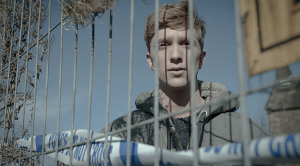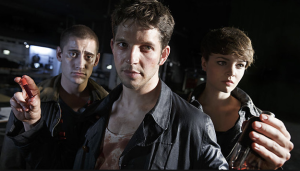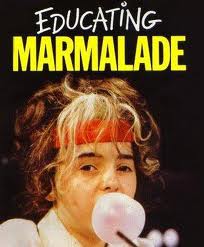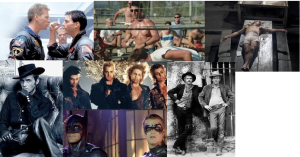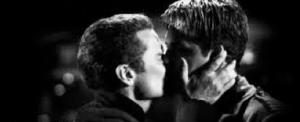Category: TV
Being Normal: the strange evolution of the TV monster
Was anyone else delighted by the opening episode of the Beeb’s latest monster bash, In the Flesh? Feeling somewhat bereft following the ending of Being Human, it was a relief to have the void filled. I’d watched the show grow over the past five seasons, witnessed the complete annihilation of its original cast, and seen it rise up and walk away utterly unscathed. Tom and Hal, in particular, are beautifully written and beautifully performed and, really, they should be given an afterlife. I’ve got all sorts of good ideas brewing if anyone at BBC3 wants to give me a shout. Although series 5 got off to a shonky start, I was gripped by the final two episodes. And gutted at the end. Gutted that it was over. And, to be honest, kind of gutted at its manner of being over. Not that I think it was poorly done or anything, it’s just that really, honestly, who wants to be human? Other than Tom, Hal and Alex of course. The narrative tackles the discordant desires of characters and audience head on. The characters win. Which got me thinking about how Being Human shifted this genre slightly, nudged its perspective just a little, and how In the Flesh seems to have taken up this baton.
Previously, the monster was all about the big bad. Sometimes the big bad was the other, sometimes nearer to home, and yes, occasionally, it was even the self, but the self as taken over by the big bad, or constructed by the big bad. If you know what I mean. Sometimes the big bad existed amongst us, tricked us into thinking it was normal, for its nefarious plans. Sometimes the big bad had human qualities, was searching for love, redemption, peace. But these shows are radical in their quest for Normality. Ordinariness. Quiet Humanity. In these shows the big bad is kind of small and all right really, most of the time. Inner demons tend to be unleashed by the inhumanity of the world at large. Humans are as likely to be monstrous as the monsters; the monsters’ humanity exceeding that of the humans. Angel once had a storyline centered around a prophecy to return a vampire to a human state. But for these newer shows, this misses the point. Being human is a state of mind not of physicality. And being human is all about being ordinary. Ordinary jobs. Ordinary homes. Ordinary friendships. Ordinary decency. And, more importantly, being allowed to be ordinary.
And there’s something delightfully British in the construction of this ordinariness. Being Human was initially set in Bristol, on an ordinary street, which was ordinary enough, but the relocation to Honolulu Heights and Barry was inspired. And the symmetry of Hal’s backstory, holed up in Southend for fifty-five years, added to the humour. There’s an American version, I haven’t seen it but I’ve heard it’s quite good, which is set in Boston. Whatever they’ve done with the US version though, I can’t imagine it much resembling the British one beyond its having a vampire, a werewolf and a ghost. Boston is not Barry. The subtlety is lost. And with it the humour.
In the Flesh has taken up the ordinary with aplomb. Roarton, a kind of fictionalised Yorkshire town, is as ordinary as it gets. Right down to the railway station. And the accents. And the family that our hero, Kieren, who exudes innocence and vulnerability, returns to, post suicide, post zombie, in his newly medicated state. These shows refuse us closed narratives of good and evil, right and wrong. Boundaries blur, distinctions fade, our own humanity is put under the microscope. This is TV for the modern age. War and guilt, the demonisation of difference, and the tyranny of moral absolutes are already emerging as themes. I look forward to seeing how this tale pans out.
Update 04.04.2013: unfortunately the tale panned out poorly. The second episode was entirely plot driven and lacked depth, nuance or character development. Despite a strong central performance, and the final episode recovering a little, this was not enough to save what could have been a great show. What a shame.
Real Vampires Don’t Sparkle… but maybe that’s the point
Ok, I can’t quite believe that I’m going to attempt this. Perhaps I should start with a disclaimer. I love Gothic fiction. I’m a big fan of the horror genre in film. I particularly love vampire flicks, and I like my vampires to have fangs. I’m interested in film. Interesting film. I’m interested in literature. Interesting literature. I consider myself a feminist. I say all this, and I could say so much more, as a kind of begging for forgiveness in advance. Because, what I’m about to do, and I can’t quite believe it myself, is offer a kind of apology for The Twilight Saga. No. More than that, offer a reason for its popularity. And more than that, suggest that, despite its deeply suspect ideology, it’s not so bad really. Bear with me, readers.
I ought to make it clear, I haven’t read a single word of a single one of the Twilight books. I don’t intend to. I probably wouldn’t like them. Which is fine. I’m fairly certain I’m not the target audience anyway. I have, however, over the past couple of weeks, watched all five of the films. I thought it was about time to have a look at just what it is, precisely, that has been preoccupying the kidz over the past few years. Or at least, that’s what I tell myself. My initial reaction was one of horror. The wrong kind of horror. I watched the films in the wrong order, starting with Breaking Dawn: part 1, which with its unflinching pro-life subtext (actually not so much of the ‘sub’) left me fearing for the ideological hearts, not to mention the psychological, and indeed physical, well-being of our teenagers. And then there’s the stalking, controlling, coercive boyfriend. And the mind games. And the ‘no sex before marriage’ clause. And the heroine seemingly free from any agency at all. And Wolfy (sorry, Jacob) imprinting on a new born babe – I’ve tried like mad to rationalise this one, but really, whichever way you look at it, it’s just creepy. And. And. And…
And what about adding to the body of Vampire mythology? Harmless ‘vegetarians’? Repeating high school ad infinitum? Driving around in Volvos and Mercedes? Living in (unaccountably affluent) peace in a Scandinavian style lodge? It’s not that this is all a bit off canon, so much as this is all a bit lame. And then there’s the sparkling. Sparkling, I tell you. Vampires don’t sparkle. They chow down on your neck with bloody great fangs. They exist as a metaphor for sex, repression, fear, desire. They offer a safe space for transgression. They explore the other. They explore the id. They DON’T BLOODY WELL SPARKLE.
But then maybe that’s the point. Maybe Edward, in all his toothless, sparkling glory is so non-threatening that the sinister undercurrents of his behaviour are rendered utterly meaningless. Maybe the adolescent and the pre-pubescent fans buy into the unreconstructed gender fantasy because it so clearly is fantasy, and requires so little exertion on their part. Maybe, surrounded as they are by a hyper-sexual, disposable culture, the innate conservatism of The Twilight Saga offers some breathing space. Maybe they just fancy Robert Pattinson. Or Kristen Stewart. Maybe they’re frightened of growing up, and they find something reassuring in Bella and Edward achieving a state of stasis while still teenagers. Or maybe they like waiting ’til the final film for Bella to actually get some muscles – a kind of delayed gratification.
Or maybe I should give up the ghost and direct you to this biting Buffy/Twilight mashup instead…
Thanks for the reminder that Real Slayers Stake Vampires. Especially if they sparkle.
Google ‘real vampires don’t sparkle’ and click on images. Go on, it’s fun.
Many thanks to Shannon for the lightbulb moment. Cheers.
Bad Girl Warning
I was having a drink with a couple of pals the other night. Our train of thought meandered from the policies of the Israeli state to the resignation of Pope Benedict to baptising babies to Methodism to Oranges Are Not the Only Fruit to, yelled out in unified bingo-style abandon, MARMALADE ATKINS! Talk about 6 degrees of separation. Now to those of you who aren’t from the UK, this last one might be a bit niche. In fact to those of you who are from the UK, but aren’t of an age to have been watching kids TV in the early 80s, or whose parents thought ITV was a bad influence – you know who you are – this will also seem a bit niche. Nonetheless, I was struck by the profoundly powerful memory we all shared of this anarchic character from the dark and distant days of three TV channels. (OK you purists, I know she started out in book form but for a whole generation Marmalade Atkins was that girl from TV). And she was our hero.
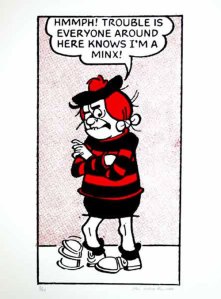
That got me thinking about other anarchic characters from my youth. Minnie the Minx. I loved her. She was my alter ego. What am I saying, there was no alter, she was my ego. She has a statue in Dundee, you know. I was an avid ‘70s Beano reader, a member of the Dennis the Menace and Gnasher fan club, had one of those badges with the wobbly eyes, but Minnie was where it was at.
In the late ’80’s Darlene, the younger daughter in Roseanne took up the banner for irreverent youth, saving those of us with no interest in Disney Princesses from a fate worse than death. And for those aspiring to more adult themes (alcoholism, sexual violence, bereavement, relationship trouble), hard-talking, gun-toting, gin-swilling Chris Cagney saw us right through the decade.
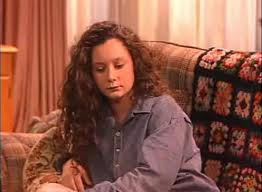
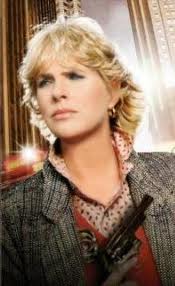
By the time I left home in the very last year of the 1980’s, TV as we had known it – a scheduled event, galvanising a family, a nation, a subculture – had only a few years left to live. There were now four channels, satellites were springing up like extra-terrestrial beings clinging to the sides of grey houses (everything was grey in the 80s). Video recorders were in vogue. Soon there would be a fifth channel. And then cable. And then internet TV.
So let’s raise a toast to simpler times and remember when a few tough talking female characters scattered first through our comics, and then across our cathode ray tube TVs, offered a bit of feisty escapism for those of us who’d never much wanted to be one of Charlie’s Angels.
Lock Up Your Daughters… Pulp’s In Town
I think, perhaps, I should stop making insulting comments about facebook in this blog and then linking it to my facebook account in the vain hope of ensnaring a reader or two. It’s not good form.
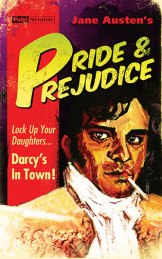 What is good, though, is that there’s a fabulous new publishing company in town: Pulp! THE CLASSICS. Its genius lies in its reprinting of select, classic bestsellers, all dolled up in pop-culture covers and ironic tag-lines. First up, of course, is Pride and Prejudice. Steamy blacks and reds mixed with pop-art yellows signal smouldering sex with just a hint of irony. I think. The tag-line reads “Lock Up Your Daughters… Darcy’s In Town!” The edition caught my eye in an instant, and I bought two, one for me (what can I say, I’m a fan, a fanatic, whatever…), and one for a pal with an eye for pop and the absurd, but who’s yet to be convinced of the wonderful worth of Miss Austen. I’m hoping to sneak her in through the side door with this version.
What is good, though, is that there’s a fabulous new publishing company in town: Pulp! THE CLASSICS. Its genius lies in its reprinting of select, classic bestsellers, all dolled up in pop-culture covers and ironic tag-lines. First up, of course, is Pride and Prejudice. Steamy blacks and reds mixed with pop-art yellows signal smouldering sex with just a hint of irony. I think. The tag-line reads “Lock Up Your Daughters… Darcy’s In Town!” The edition caught my eye in an instant, and I bought two, one for me (what can I say, I’m a fan, a fanatic, whatever…), and one for a pal with an eye for pop and the absurd, but who’s yet to be convinced of the wonderful worth of Miss Austen. I’m hoping to sneak her in through the side door with this version.
Of course, they got the tag-line wrong. If they wanted to go with the locks and daughters theme, it should have read, “Lock Up Your Daughters… Wickham’s In Town!” He is, after all, the one with a penchant for seducing 15 year olds. Where’s the fun in dwelling on technicalities, though? What’s more interesting is the enduring appeal, and the ongoing mythologising, of Darcy in the popular consciousness. On this cover, Darcy is Colin Firth, but Colin Firth as he might be cast as Dracula (Regency outfit aside), all lurking in the shadows and glowering menacingly, fag in mouth. Wait a minute. Fag in mouth? Well ok, so 50s alienated anti-heroes are also evoked – Rebel Without a Cause anybody? Or maybe there’s just a hint of our fave cigarette-smoking bad-boy vampire, Spike, in this little construction.
Anyway, for my money, this is a welcome addition to the publishing high street. Forthcoming editions will include Wuthering Heights and The Great Gatsby. Keep an eye on those daughters, now.
Once More with Feeling
Readers of this blog will know that I recently chalked up a sustained absence from facebook, for which I felt duly smug (and, incidentally, to which I may return as my reactivated facebook account is fed on a daily basis with such sheer banality that it is increasingly a relief rather than a struggle to limit my usage). What I didn’t ’fess up to was that during that 37 day abstinence, I discovered LOVEFILM Instant. Technology will pull you in one way or another.
Now I have, on occasion, used LOVEFILM Instant in a grown-up, and well-reasoned sort of way. I’ve caught up on some films that I’d never have bothered to see at the cinema: Source Code, despite its schmaltzy ending, was kind of fabulous. But I have to be honest here: LOVEFILM Instant, for me, is really all about Buffy.
Of course, I loved the show the first time round. Who didn’t adore Willow and by extension first Oz, and then Tara? And with looks so utterly preposterous yet inexplicably cool, when Spike rolls into town, mowing down the ‘Welcome to Sunnydale’ sign on his way, who didn’t secretly want to be him? A heady mix of the ridiculous and touchingly human, amoral yet vulnerable, moronic but somehow insightful; this was a Vampire we could all fall for. And how we did.
10 years on from the emotional roller-coaster of that last ever episode, I have lost hours, no days, maybe even weeks, to the void, and LOVEFILM Instant is to blame. Every single episode, right there, ready at a tap of the touchpad. And when you build in all that extra buffering time to the Buffyverse, (my broadband, it would seem, ain’t all that broad) well, that’s a lot of time. I wonder how it stacks up against my last few years of facebook use? Whatever the maths though, I reckon weeks lost to the Buffyvoid are, when all is said and done, weeks worth losing. Because, this programme stands the test of time. In 2013, Buffy seems better than ever. Quirky. Straight. Tragic. Comic. Light. Dark. It’s all there in those 40+minute episodes, across the arcs of each season, all the way from ‘Welcome to the Hellmouth’ to ‘Chosen’. But what really does it for me, is the sheer scale of well drawn, central female characters. How often do we get to see this on screen? Recent British TV pales by contrast: the current season of Being Human is sorely disappointing. Can that ghost actually be said to possess a character? That is not rhetorical – please, somebody, tell me. Nor metaphysical. And what about the last season of The Hour? Is it possible to believe that that ineffectual, quivering-lipped, poor excuse for a boss actually heads up a crack, cutting-edge, current affairs programme? And don’t get me started on the wan’n’wistful-pseudo-French-pseudo-marxist-wifey who rocked up out of nowhere – all Jean Seberg crop and no trousers. What the hell were the writers thinking? Were the writers thinking? Here’s to Detective Inspector Sarah Lund. And please, please, please can we have some more kick-ass women on screen? Oh, and bringing back Spike wouldn’t hurt either.
Update: series 5 of Being Human got better. Not quite series 4 better, but it was a hell of a shame to see it go. The ghost improved. A little. But female characters remain the weakest on the show. Still, bring back Tom and Hal. Please.
Unchained Melody
So, Twitter has been hacked and passwords stolen ‘n’ it’s all just so awful. On the plus side, if the hackers have got my details, I’d really appreciate a reminder coz I can’t keep any of my trillion or so passwords in my head. Can anyone?
After my ‘Lincoln’ induced rant last week (oh, and don’t get me started on ‘Life of Pi’ popping out of the screen at me like Disney on acid) my faith in cinema has been somewhat restored, though not entirely without reservation, by ‘Django Unchained‘. Thanks Jamie Foxx: dodgy moniker aside, you make a mean cowboy. I won’t go any further here as controversy enough surrounds this flick, and you can pick up reviews and follow microblog spats to your heart’s content all across cyberspace. Perhaps there’s a point to blogging.
However, this restoration of faith has been just a little shaken by the news that Steven Soderberg’s taking his leave of Hollywood. I understand that I’m a bit behind the times on this one, rumours have been circulating for a while, but I only caught up on the news a few days ago. I must admit to having a soft spot for Soderberg – who doesn’t love Clooney and J-Lo in the boot of that car? Does anyone know what make of car that was, anyway?
Perhaps he’s right, though – perhaps the really interesting work has migrated to television. Still, it seems a shame that while the House of Commons dragged itself into the 21st century and voted to legalise gay marriage last night, leaving the embittered entrails of Roger Gale splattered on the chamber floor (an added bonus), across the pond Soderberg says that Hollywood studios are still refusing to fund projects deemed too gay. So, I thought I’d put together an itsy, pretty montage of leading-man moments that inexplicably slipped beneath the studio bosses gaydar:
And let’s not leave TV out of the picture. No subtext here – this one’s for you Roger:

